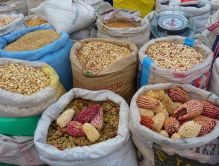
If you teach a culinary foods class, you no doubt include a unit on grains. While there are a lot of options for working with grains, the material can be a bit dry to teach. Thanks to Nebraska FACS teacher, Sarah Smith, this doesn’t need to be the case. Her “Cooking with Grains” is an interactive lesson you will want to try with your students!
Set
- Sarah begins by asking her students to brainstorm a list of different grains. Additionally, she asks them to name a dish that corresponds with each grain brainstormed.
- After sharing, she explains that they will be exploring methods to maximize the flavor and texture of grains.
Materials
- Game Pieces (buttons, paper clips, etc.)
- Printed Game Board & Playing Guide
- Printed Spinner (fastener attachment)
- Grain Game Cards (cut apart & laminated)
Activities
- Students read the article titled, “How to Cook Farro (and Literally Every Other Grain) Perfectly, Every Time“. In groups they complete a graphic organizer about the lessons learned from the article.
- Next, provide students with a game board and pieces. When it is each player’s turn, they will spin the electronic spinner.
- The spinner will determine which grain cooking characteristic needs to be focused on from the drawing cards. The cards describe the grain and how it should be cooked.
- They will move their piece forward based on the characteristic of the grain that the spinner indicates to focus on and on the key provided by the guide. For example, if the spinner lands on “pre-cooking preparation” and the drawn card indicates that the grain needs to be rinsed, it would move one space. If the grain requires more than one cup of water, it would move two spaces.
- In summary, each player will draw from the pile of cards. They will review the characteristics of the grain drawn. Then, they will use the spinner to determine the number of spaces jumped. If the spinner lands on “water needed,” read the description for how much water is needed and reference the playing guide to determine how many spaces forward you will move.
- To conclude the lesson, give each student a piece of paper. Ask them to recall one fact from the reading or board game. Then, they will pass their paper to the person on their right. They will read the fact on the new piece of paper and write a new fact (still different from their own previous fact). Continue this process until the paper has made its way back to the original owner. As the paper passes, each person should avoid repeating facts they have already used or that are on the paper in front of them.
- A grains cooking lab follows where students apply and compare the various grain cooking methods information they just learned!
- NOTE: Sarah’s class periods are 50 minutes long.
Attachments
- Grain Lesson
- Maximizing Flavor & Texture of Grains Graphic Organizer (PDF)
- Grains Gameboard & Spinner
- Grains Playing Guide
- Grain Game Cards
- 3 Grains Cooking Comparison Lab (PDF)

